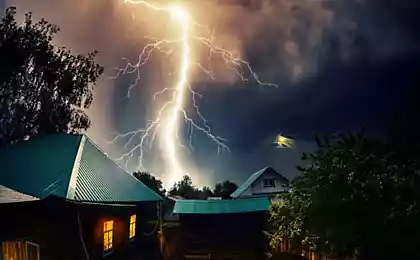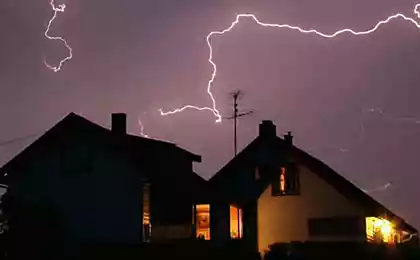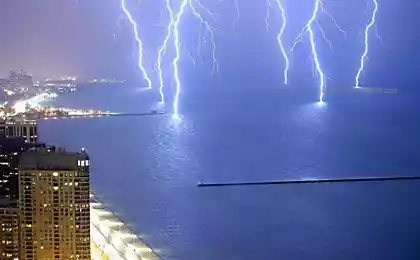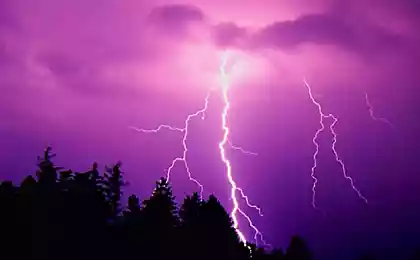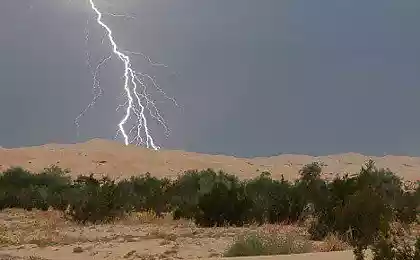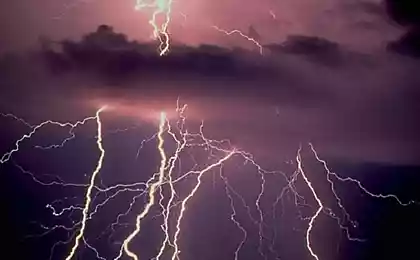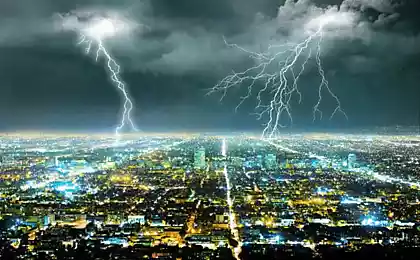515
How to protect the house from lightning?
Is it possible to do without a lightning rod?In any case! For a number of reasons.
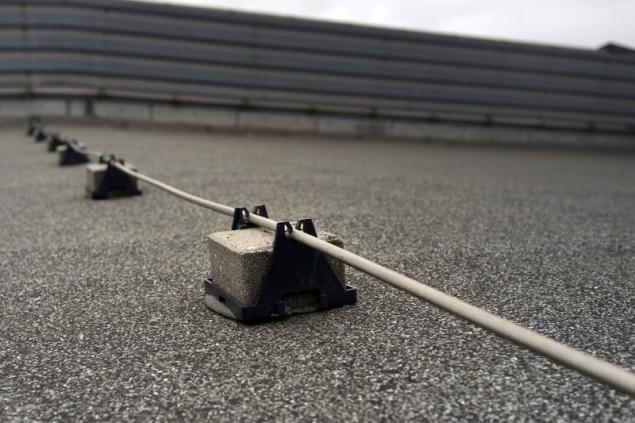
A lightning protection device: do you have instructions?Unfortunately, for some reason, still there is no official regulations stipulating the guidelines and requirements for design of lightning protection of private houses. In each case, designers and homeowners have to rely on common sense and experience electricians. The only practical advice that should be followed strictly: think of lightning protection as early as possible, even at the stage of designing the house and laying the Foundation. In individual residential buildings lightning protection is finally established at the stage of wiring electricity in the house.
Device lightning protection system: how it madelightning protection System consists of several parts: the lightning shunts, grounding, and special equipment, which is connected to the breaker box and protects the network from power surges. Electricians call the first three elements of the external lightning protection, and the device in the dashboard.
Lightning the simple structure, the metal pins, which height depends on the height and area of the building. So, for a building height of 8 m and an area of 80-100 sq. m. will need a pin length of about 1.4 m. For the attic-mezzanine you need a separate power collector, which is installed on the ridge of its roof.
The electrodes join the lightning — two for each pin. To ground they have to go by the shortest route. That is why experts strongly recommend to take care of the lightning still in the design stage: the laying of the electrodes of the already built house on the way may meet the window, besides it will be difficult to make a reliable insulation of the electrodes and hide them in the internal elements of the house.
If you can not to lay the electrodes on the shortest path, their number increase, and the lightning connect. Therefore, the current from the receivers is distributed in different directions.
Ground is usually the Foundation where it is still at the stage of laying shall be provided details for attaching the current collectors. If such items are not, in the Foundation of separate drive pins and are interconnected. To the ground does not corrode, it is better to use elements made of galvanized metal.
For the house, standing on a high sand hill, additional ground loop: dry sand — poor grounding.
Remember: metal shell all underground utilities cottage must be associated with the ground loop!
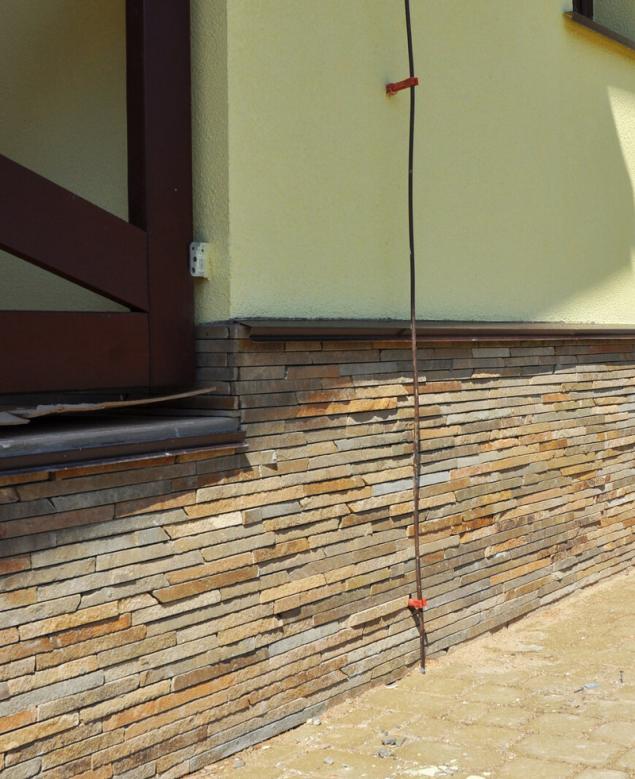
Alternative lightning protection devicesMedicationabana and more reliable lightning protection system compared with the pin — lanyard. On the roof ridge set two small pin, between which there is an uninsulated wire. The whole structure is a susceptor.
On city buildings used another option — molniezaschita network. It is a metal grid with large cells laid over the whole area of the roof. The wires are usually tucked away in the concrete floor of the roof. This technology is also suitable for small private houses, but adjusted the wires it is recommended to lay on top of the roofing material, or after a lightning strike, the roof will be repaired.
Important: molniezaschita network is only used for non-metal roofing! Outside the network there should be no metal parts including the drains.
Metal roofing when properly grounded can work as a great lightning. Most importantly, that it was not combustible insulation where contact with metal zipper can be very hard to heat up and even melt. By the way, for this reason it is better to use other options lightning protection: repair damaged roof can cost a lot.
It is believed that tile roofs safer metal. In fact, the probability of a lightning strike does not depend on the roofing material. By itself, ceramic is a good insulator, but any metal object (nail, pipe) under a layer of tiles brings this advantage to nothing, because direct lightning strike will easily smash even the thickest tile.
Construction of cottage settlements can be used external lightning protection system of the active type, which covers several buildings. It is based on the principle of ionization of air near the lightning conductor and mounted on special masts. Lightning active type is at a distance of 1 m from the highest point of buildings in the settlement, the coverage area of the active system is about 80 sq. m.
published
P. S. And remember, only by changing their consumption — together we change the world! ©
Source: www.supersadovnik.ru/text/kak-zaschitit-dom-ot-molnii--1004571
- The probability of a lightning strike to the house, though small, but still exists. Especially if the structure rises above all others, sits on top of a hill or on the waterfront.
- Direct lightning strike is not the only danger during a lightning storm. For the electric circuit of the house and connected to her art and the threat of lightning within a radius of 200-500 meters: they cause severe electromagnetic disturbances. Can damage equipment and lightning surge, caused by rapid changes of the electromagnetic field during a thunderstorm.
- Lack of lightning may be cause of refusal to pay insurance indemnity in case of fire.

A lightning protection device: do you have instructions?Unfortunately, for some reason, still there is no official regulations stipulating the guidelines and requirements for design of lightning protection of private houses. In each case, designers and homeowners have to rely on common sense and experience electricians. The only practical advice that should be followed strictly: think of lightning protection as early as possible, even at the stage of designing the house and laying the Foundation. In individual residential buildings lightning protection is finally established at the stage of wiring electricity in the house.
Device lightning protection system: how it madelightning protection System consists of several parts: the lightning shunts, grounding, and special equipment, which is connected to the breaker box and protects the network from power surges. Electricians call the first three elements of the external lightning protection, and the device in the dashboard.
Lightning the simple structure, the metal pins, which height depends on the height and area of the building. So, for a building height of 8 m and an area of 80-100 sq. m. will need a pin length of about 1.4 m. For the attic-mezzanine you need a separate power collector, which is installed on the ridge of its roof.
The electrodes join the lightning — two for each pin. To ground they have to go by the shortest route. That is why experts strongly recommend to take care of the lightning still in the design stage: the laying of the electrodes of the already built house on the way may meet the window, besides it will be difficult to make a reliable insulation of the electrodes and hide them in the internal elements of the house.
If you can not to lay the electrodes on the shortest path, their number increase, and the lightning connect. Therefore, the current from the receivers is distributed in different directions.
Ground is usually the Foundation where it is still at the stage of laying shall be provided details for attaching the current collectors. If such items are not, in the Foundation of separate drive pins and are interconnected. To the ground does not corrode, it is better to use elements made of galvanized metal.
For the house, standing on a high sand hill, additional ground loop: dry sand — poor grounding.
Remember: metal shell all underground utilities cottage must be associated with the ground loop!

Alternative lightning protection devicesMedicationabana and more reliable lightning protection system compared with the pin — lanyard. On the roof ridge set two small pin, between which there is an uninsulated wire. The whole structure is a susceptor.
On city buildings used another option — molniezaschita network. It is a metal grid with large cells laid over the whole area of the roof. The wires are usually tucked away in the concrete floor of the roof. This technology is also suitable for small private houses, but adjusted the wires it is recommended to lay on top of the roofing material, or after a lightning strike, the roof will be repaired.
Important: molniezaschita network is only used for non-metal roofing! Outside the network there should be no metal parts including the drains.
Metal roofing when properly grounded can work as a great lightning. Most importantly, that it was not combustible insulation where contact with metal zipper can be very hard to heat up and even melt. By the way, for this reason it is better to use other options lightning protection: repair damaged roof can cost a lot.
It is believed that tile roofs safer metal. In fact, the probability of a lightning strike does not depend on the roofing material. By itself, ceramic is a good insulator, but any metal object (nail, pipe) under a layer of tiles brings this advantage to nothing, because direct lightning strike will easily smash even the thickest tile.
Construction of cottage settlements can be used external lightning protection system of the active type, which covers several buildings. It is based on the principle of ionization of air near the lightning conductor and mounted on special masts. Lightning active type is at a distance of 1 m from the highest point of buildings in the settlement, the coverage area of the active system is about 80 sq. m.
published
P. S. And remember, only by changing their consumption — together we change the world! ©
Source: www.supersadovnik.ru/text/kak-zaschitit-dom-ot-molnii--1004571
